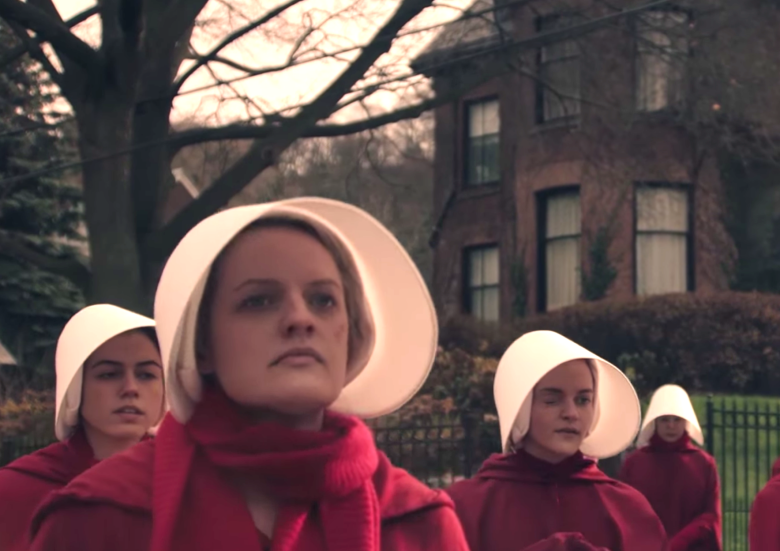Wednesday
With Hulu set to release The Handmaid’s Tale tomorrow, I have gathered together all the posts I’ve written on Margaret Atwood’s dystopian classic. As several observers have pointed out, the series, which would have seemed merely interesting had Hillary Clinton been elected president, seems urgent now that we have a “pussy grabber” in the White House and learn more daily about the toxic misogynist culture at Fox News.
Nor would things be much better if Donald Trump were impeached. Mike Pence not only is a firm opponent of abortion, Planned Parenthood, and various forms of birth control, but he even fears being alone with women. The religious right salivates over the prospect of either Trump or Pence replacing the aging Ginsburg and Breyer with rightwing justices who will overturn Roe v Wade. Atwood reminds us that the desire to control women’s bodies never entirely leaves political conversations.
Those rightwing women who have signed up for the campaign should be wary, however. Sarah Jones’s recent New Republic article advises women like Trump advisor Kellyanne Conway to read Handmaid’s Tale as it has lessons for them as well. If they lash their wagons to misogynist men, they may end up like the frustrated Serena Joy, a powerful woman who helps bring the fundamentalists to power and then finds herself confined to her husband’s home.
Jones describes how reading Handmaid’s Tale while attending a religious college prompted her to leave the church. She was struck by how, at her school, rightwing women used feminism’s tools to advance measures designed to oppress women. This is exactly what happens in Atwood’s novel:
My alma mater capitalized on the “pro-woman” claims established by Schlafly and her ilk. Their greatest achievement was to take a language of female empowerment from the women’s movement and turn it to their own purposes. No one has noted this inversion more ruefully than Atwood. Offred’s mother, we are told, was a second-wave feminist. She envisioned a porn-free society that would largely exclude men. “You wanted a women’s culture,” Offred imagines telling her. “Well, now there is one. It isn’t what you meant, but it exists.”
In the Tale, this paradox is exemplified not just by Serena Joy but by Aunt Lydia. Cruder and lower-ranked, Aunt Lydia is the hand that wields the cattle prod. She’s charged with the re-education of future Handmaids, and she accomplishes this by emphasizing both the high value of women and the necessity of their oppression. “A thing is valued,” she teaches, “only if it is rare and hard to get. We want you to be valued, girls…. Think of yourselves as pearls.” Serena Joy chose her life. Lydia is empowered to attack other women with a cattle prod. Both are proof that women are represented in Gilead’s power structure. If feminism is only about representation, choice, or some vaguely sketched notion of empowerment, it is difficult to say our Serena Joys and our Aunt Lydias are not feminists.
Feminism has to stand up for the freedom of all women, not just some women, Jones says:
The Handmaid’s Tale does more than present a possible future: It asks us to consider how we’d end up there. A form of feminism that celebrates power for power’s sake, instead of interrogating how it is concentrated and distributed, will usher us into fascism. Feminism means something. Some choices oppress the women who make them, and some beliefs, if enforced, would oppress everyone else, too. Allow an antichoice woman to call herself a feminist, and you have ceded political territory that you cannot afford to lose. Stripped of political meaning, “feminist” becomes an entirely subjective term that anyone with any agenda can use.
Fortunately we’re not in Atwood’s world yet, perhaps because we haven’t had the environmental or nuclear cataclysm that Atwood sees as a necessary precondition. But like many liberals since the election, I have taken to periodically reminding myself, “The price of liberty is eternal vigilance.”
Atwood’s masterpiece helps us remain vigilant.
Previous posts on The Handmaid’s Tale
GOP Christians Send Readers to Atwood (Feb. 2017)
Margaret Atwood’s “Handmaid’s Tale” is topping bestseller lists at the moment. The reason is probably because of the GOP’s prospect of success in curbing reproductive freedom.
Schlafly, Model for Atwood’s Serena Joy (Sept. 2016)
Recently deceased Phyllis Schlafly served as the model for Serena Joy in Margaret Atwood’s dystopian novel “Handmaid’s Tale.” Because Serena Joy gets the society she says she wants, however, her life turns bitter. Schlafly was lucky to live in a society that allowed women to have their own careers.
Teaching Gender Sensitivity at West Point (Feb. 2015)
Margaret Atwood’s “Handmaid’s Tale” is required reading for entering West Point cadets. Good things could happen.
Is Atwood’s Dystopia Coming True (July 2013)
With the rise in state legislatures passing anti-abortion legislation, Atwood’s “Handmaid’s Tale” seems more relevant than ever.
Threatened by Female Empowerment (Oct. 2012)
Atwood’s “Handmaid’s Tale” addresses issues raised by the Taliban shooting of a Pakistani school girl and also speaks to our abortion fights.


